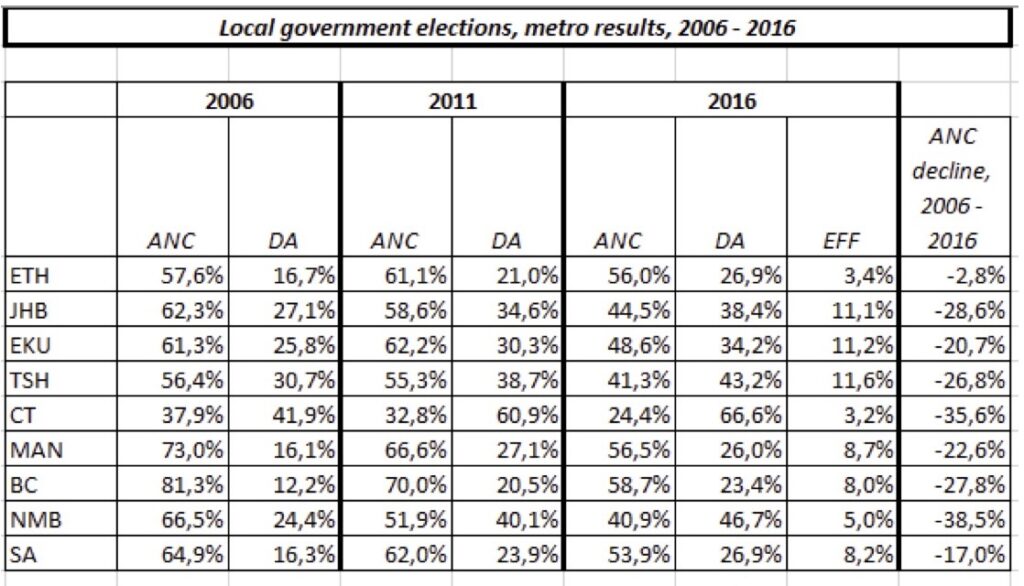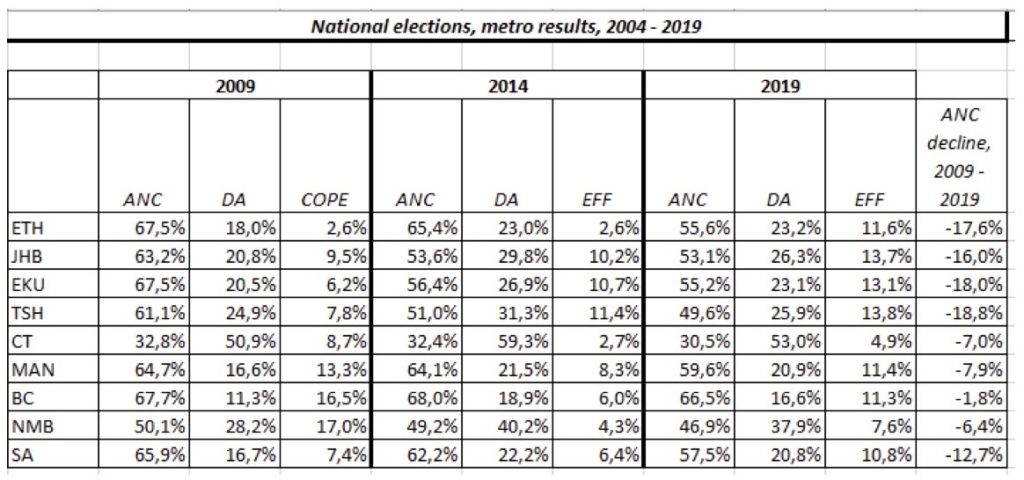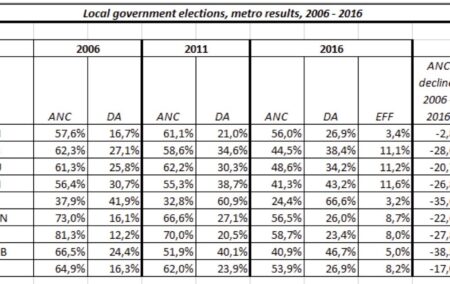As the saying goes, the way to eat an elephant is one bite at a time. And the same goes for ending the ANC’s electoral dominance – the way to beat the Grand Old Party of South African politics is one election at a time.
The party still has a comfortable electoral majority at national level and in most of the eight provinces it governs. However, it is clear that the ANC’s majority is slowly being chipped away and the point at which the party fails to win a majority in this country is not far off.
Decline in the cities
Perhaps where ANC support has declined the most is within our cities and this is where we should look to see where the country is headed. Cities often act as harbingers for what is to come for the rest of a country. Political change often begins in metropoles and then diffuses into the rest of society.
As the 1 November date for local government elections has now been confirmed, examining the pattern of ANC decline in our cities can be a signpost indicating what we can expect and who could be governing our biggest urban areas in eight weeks or so from now.
Of course, there are changes in electoral patterns outside of the cities that can also illuminate our understanding of South African electoral politics but for the purposes of this article the (outsize) role of our cities will be the focus.
Looking back to three election cycles ago, in the 2006 municipal elections the ANC won nearly 65% of the vote nationwide while the DA managed 16%. If we look at the results in the cities – defined for our purposes here as our eight metropolitan municipalities (Johannesburg, Nelson Mandela Bay, Cape Town, Buffalo City, Tshwane, Ekurhuleni, eThekwini, and Mangaung) – the ANC was almost completely electorally dominant.
Of the eight cities the ANC failed to win more than 50% of the vote only in Cape Town, where it managed 38%, while the DA managed 42%. The DA managed to cobble together an unwieldly coalition to govern the city but an ANC-led front to govern the city had almost been a reality.
In the other seven cities the ANC won above 50% in each and a whopping 81% of the vote in Buffalo City (East London).
Ten years later the picture was substantially different. The 2016 election – with President Jacob Zuma casting a long shadow over South Africa’s body politic – showed how the ANC juggernaut was under threat and while not sinking, was certainly beginning to list.
While the ANC had enjoyed majorities in seven of the eight metros in 2006, in 2016 it could only manage above 50% in eThekwini (Durban), Buffalo City, and Mangaung. It was the largest party in Ekurhuleni and Johannesburg but failed to win more than 50% of the vote in those places.
Perhaps the most marked decline was in Nelson Mandela Bay where it won only 41% of the vote in 2016, in contrast to having secured two thirds of the city’s vote a decade earlier.
Nationally the party won just under 54% of the vote while the DA secured nearly 27%.

National election patterns
If we look at results in our cities from the last three national elections, a similar pattern emerges. The drop in overall ANC support is not as steep but the pattern holds.
In 2009 the ANC secured more than 50% in seven of the eight metros, with Cape Town once again being the only one where it was below this mark. In all the other metros it also won over 60% of the vote, with the exception of Nelson Mandela Bay, where it won just over 50%.
A decade later it couldn’t manage 50% in three metros (Cape Town, Tshwane, and Nelson Mandela Bay) and could secure above sixty percent only in Buffalo City.

What the above shows is that in the space of just three elections (three national and three local elections) the ANC has seen its overall vote share shrink by about ten percent overall. In some metros this decline has been even steeper.
Coalition governments
If this decline continues on 1 November, expect even more coalition governments across the country, and not just in the cities. In 2016 the ANC was forced to secure deals with smaller parties to hold on to power in some municipalities while in other municipalities opposition coalitions managed to snatch the keys to the mayoral office from the national governing party. Expect this trend to continue, with coalition municipal government becoming the norm across South Africa rather than the exception.
But the key trend from the above is how quickly support for the ANC declined. As stated at the beginning of this article the easiest way to eat an elephant is to eat it one bite at a time, and the best way to chip away at a hegemonic party’s dominance is one election at a time. However, what should concern the ANC is that it seems the opposition has now developed a taste for taking bites out of ANC support, and the bites are now becoming bigger and bigger.
South Africans need to start thinking about what the country will look like when the ANC no longer stands astride it like a colossus. Given the rapid haemorrhaging of its support, that day could be upon us sooner than we think. The elections on 1 November will be an important marker in showing us how close we are to a post-ANC South Africa. And South Africans need to be ready for a post-ANC future.
If you like what you have just read, support the Daily Friend

